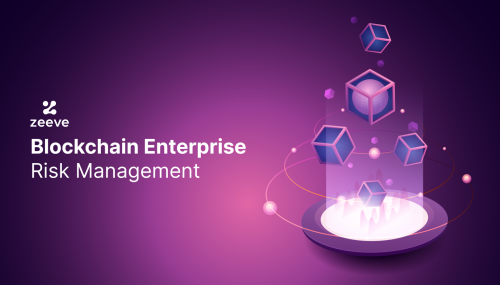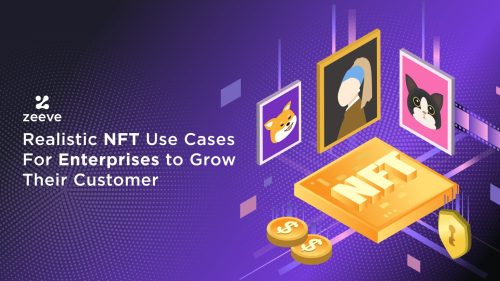
Navigating Blockchain Risks: A Guide to Effective Risk Management
Businesses looking for substantial improvement in their systems readily adapt to new technology, and one of them is blockchain. The blockchain network solves the trilemma — decentralization, security, and stability.
However, any technology isn’t completely safe from risks. Enterprises should especially have tightly guarded security management. The security layers should add up so that no intrusion happens on the network.
An enterprise blockchain has a trusted record of data, which is controlled by assembling organizations and a few of the selected third parties. In the coming years, disruptive technologies will change the way we work. Despite having a knowledge gap, nearly 90% of companies are ready to embrace blockchain solutions. But embracing the solutions need to be strategized as there are different types of consensus mechanisms for different organizations.
The legendary consensus mechanism, such as the Proof-of-work & the Proof-of-stake, doesn’t work well with enterprise blockchain management. Even the enterprise Ethereum blockchain has a customizable consensus mechanism. Some notable enterprise blockchain networks are Corda, Hyperledger, Tezos, and many more.
Let’s take a look in the article on how blockchain enterprise risk management works and the various risks associated with it.
Does Blockchain Bring Risks?
There should be continuous innovation in any company. The innovation brings easiness, reduces the time spent on doing things, and overall streamlines the process. However, it is risk management that is ultimately crucial for any company. Usually considered the safest, the blockchain is broadly divided into two categories. Let’s know about the classification to understand how data handling is done.
Permissioned Network
Enterprises can mainly opt for the permissioned network. The perks of being on the permissioned network are that it isn’t publicly accessible. The information is, therefore only accessible by users. The permissioned networks have an established governance model. The permissioned seems a good idea as the number of interactions on the network is controlled.
However, the real risk arises when the security lies in the hands of a few members. System permissions should be set properly so that malicious parties cannot merge to cause risks.
Permissionless Network
There aren’t any restrictions to joining the network, and there isn’t any KYC associated. However, the network is slow compared to the permissioned network. Furthermore, the permissionless networks are known for various attacks, one of them being the most legendary, the 51% attack.

Fig: The graph gives a clear indication that more and more enterprises will adopt blockchain in the next decade (Source)
Role of Smart Contracts in Risks
The type of network is what companies can select. However, a large number of risks hover over smart contracts. At the same time, smart contracts make the work easier. The malicious actors know that it’s a bridge where there is easy entry. Unbelievably, there has been a 1250% increase in smart contract hacks from 2020 to 2022.
Other than crafting the smart contract diligently, a smart contract audit company is also necessary to certify the contracts. The company can do an extensive audit for the contracts. Generally, in such cases, a blockchain deployment and management platform handles everything — from the blockchain infrastructure to the audit of the smart contracts.
Types of Risk on Enterprise Blockchain
Standard risks are the risks that are considered common in most the blockchain-based projects. A few of the standard risks are:
Strategic Risk
Firms need to evaluate if they want blockchain or not. In either case, the enterprises should develop a strategy. If there isn’t any need for blockchain, then the work can be done by sharing the APIs.
Reputational Risk
Reputational, as the name suggests, is the risk that happens when a company claims to have integrated blockchain. However, they still need help integrating blockchain technology into legacy systems. An enterprise needs to learn the limitations that come with blockchain implementation.
Business Continuity Risk
There can be cyberattacks that occur when there is a change in the governance rules. Since on a business network, many changes are happening simultaneously. A hacker can use it as a way to enter the ecosystem. Business organizations can manage these risks by having a short response timing when changes are scheduled to happen.
Ops & IT
Changes to standard operating procedures and policies can be challenging and risky. It is also essential that the business’s new processes are incorporated into the change.
Regulatory Risk
Regulatory problems arise as various governments have various regulations, and global companies find it challenging to manage and comply with them. There are regulatory bodies such as FINRA that manage the regulations.
Contractual Risk
This defines how the service-level agreements are managed within the blockchain nodes. The contractual risks are further well explained in the risks of the smart contract.
Information Security Risk
There is cryptography that makes the network safe, and the distributed database allows easy access to information. Thus the blockchain in itself is very secure, but the wallet needs to be kept safe. You will not always get a prevalent wallet security option.
Supplier Risk
There are third-party associated risks when enterprises go for a blockchain-based setup. The technology is acquired from third parties, and therefore there is always a risk associated with it.
Smart Contract Risk
Smart contracts, similar to other contracts, have financial and legal agreements on the blockchain. The code gets executed by itself when the parties follow the instructions. Some of the risks associated with smart contracts are:
Legal Risks
The permissioned network employed in the enterprises uses a closed-decentralized procedure while the contract is formed. This can lead to legal issues if the contract is terminated later. Legal risks also make organizations cautious about whether to adopt the blockchain network or not. Contract enforcement should not be done in a way that there aren’t any legal issues in further stages.
Business and Regulatory Risks
Contracts defined in a smart contract framework represent agreements between parties on business, economic, and legal issues. Therefore, the agreements on the contract will apply in a logical & consistent manner to all participants across the network. It becomes very necessary to go through the contracts and understand the regulations in it.
Information Security Risk
Inadequately coded smart contracts can lead to security risks, counting external or internal breaches. Any of the nodes that are causing a risk should be cut short immediately.
Value Transfer Risk
The best part of a blockchain network is that enterprises can send information on assets, identities, etc., in real time. In the peer-to-peer information exchange, certain risks need to be taken care of.
Consensus Protocol Risk
Different consensus protocols have different ways of handling assets. Enterprises will have to analyze the consensus protocols to understand what works for them. As different protocols have different types of risks deploying an enterprise-based consensus mechanism will be favorable.
Data Confidentiality Risk
Even on the secure permissioned network, there is a metadata. The metadata cannot be changed and is permanent. However, the metadata is also a way to get public addresses. It can trace any public address on the blockchain framework and get information to the participant node. On the permisisoned network, a hashed format conveys the transaction information and is secure. However, the hashed format reveals how many participants were involved in the transaction and what the transaction was about.
Key Management Risk
The key management during the value transfer is essentially important. The private keys must be kept safe as there are high chances of theft. The accidental loss of the key is irretrievable. To be noted, there isn’t a single controller, and therefore there can be an aggravation within the framework. The management of the keys mainly depends on the users.
Liquidity Risk
You must have a lot about the liquidity risks in a centralized network. Consequently, it is also very much possible on the decentralized network. Therefore, the clearing and settlement will require a pre-determined dispute resolution system.

How do we at Zeeve Approach the Blockchain Risks?
Since we have been working with many renowned organizations, we know that risk management is a deliberate task. Firstly, there is an overall analysis of the blockchain data. Our team creates auditable records of the data.
One of the brilliant solutions to manage blockchain-related risks comes from the administrators. The administrators define the security controls and develop a risk model per the enterprises. Then further apply the conventional security controls. Once the risk management model is done, we enforce business controls. To manage the risks of enterprise blockchain:
- Zeeve constantly monitors the pool and alerts if there is a certain percentage of surpassing of the miners.
- As smart contracts are vulnerable to various types of attacks. Zeeve does testing of the contracts handling any attacks.
- There are security protocols which are very handy when it comes to handling routing attacks.
- Zeeve uses the security softwares that allows the monitoring, KYT, navigation assistance and a virtual asset service provider to manage the risks.
Concluding Thoughts
The awareness of all the issues in a blockchain network is imperative for a secure environment. Less knowledge may make your organizations prone to many risks. With the right planning, the unwanted blockchain-related risks can ward off once the workers are properly trained. In 2024, global spending on blockchain-based solutions will reach $19 billion. It predicts how the technology is going to be beneficial in the coming days.
The blockchain will change how we trust a transaction process where there will be less human interference and more trust in the algorithm. Any framework will require a roadmap for testing and implementation. This is when a blockchain infrastructure management platform comes into the picture. As an enterprise, when there is already a lot going on in the backend, and your goal is to adopt blockchain. Then the best would be to partner with a blockchain infrastructure management platform.
Partner With Zeeve
Make your enterprise blockchain ready with Zeeve. We have an extensive blockchain risk management process. Our team analyzes the critical business assets and understands the potential threats at an early stage.
Know more about us through our blockchain-related trendy Twitter spaces. Further, connect with us on Telegram, and let us understand more about your organization. Set up a call with Zeeve if you wish to discover more about our Blockchain Infrastructure Management Platform.






Responses